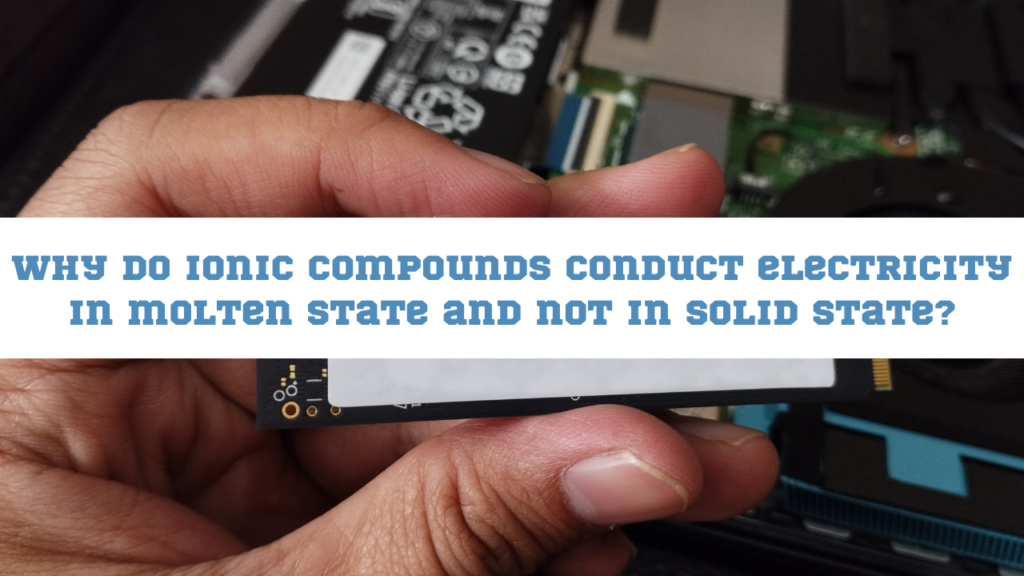Why do ionic compounds conduct electricity in molten state and not in solid state?

Ionic compounds are formed when atoms gain or lose electrons, resulting in ions held together by electrostatic forces. They typically consist of positively charged cations and negatively charged anions. While they possess unique properties, one notable characteristic is their behavior regarding electrical conductivity, especially in different states.
Conductivity in Solid Ionic Compounds
In their solid state, ionic compounds do not conduct electricity effectively. This is because the ions are locked in a rigid lattice structure, unable to move freely. Although there is an abundance of charged particles, they cannot carry an electric current as they are unable to flow.
Behavior of Ionic Compounds in Molten State
However, when these ionic compounds are melted, the situation changes dramatically. In the molten state, the lattice structure breaks down, and the ions become mobile, free to move throughout the liquid. Consequently, molten ionic compounds are excellent conductors of electricity.
Ionic Bonding and Electron Mobility
The conductivity of ionic compounds in their molten state can be attributed to the nature of ionic bonding. In solid form, the strong electrostatic forces hold the ions in fixed positions, preventing them from moving. Yet, when the compound is molten, the ions gain enough energy to overcome these forces, enabling them to move and carry electrical charge.
Factors Affecting Ionic Conductivity
Several factors influence the conductivity of molten ionic compounds. These include:
- Temperature: Higher temperatures increase the kinetic energy of ions, enhancing their mobility and thus conductivity.
- Nature of ions: Smaller ions with higher charge densities tend to exhibit greater mobility and conductivity.
- Presence of impurities: Impurities can disrupt the lattice structure, facilitating ion movement and increasing conductivity.
Temperature Dependence
Temperature plays a crucial role in the conductivity of molten ionic compounds. As temperature rises, the kinetic energy of ions increases, allowing them to move more freely. Consequently, conductivity also increases with temperature.
Comparison with Metallic and Covalent Conductors
While ionic compounds conduct electricity in the molten state, they behave differently from metallic and covalent conductors. Metallic conductors have delocalized electrons that can move freely throughout the solid, while covalent conductors rely on the movement of electrons within covalent bonds.
Applications and Importance
The ability of ionic compounds to conduct electricity in the molten state finds various applications. It is utilized in processes such as electrolysis, where electrical currents are passed through molten ionic compounds to facilitate chemical reactions and extract metals from ores.
Conclusion
In conclusion, ionic compounds conduct electricity in the molten state due to the mobility of ions, which is facilitated by the breakdown of the rigid lattice structure. This property is vital for numerous industrial processes and demonstrates the versatile nature of ionic compounds.
FAQs
1. Why do ionic compounds conduct electricity in the molten state?
- Ionic compounds conduct electricity in the molten state because the ions become mobile and can carry an electric current.
2. Can solid ionic compounds conduct electricity?
- No, solid ionic compounds cannot conduct electricity as the ions are locked in a rigid lattice structure.
3. How does temperature affect the conductivity of molten ionic compounds?
- Higher temperatures increase the mobility of ions, leading to enhanced conductivity.
4. What role does ion size play in ionic conductivity?
- Smaller ions with higher charge densities tend to exhibit greater mobility and conductivity.
5. What are some applications of the conductivity of molten ionic compounds?
- Molten ionic compounds are used in processes such as electrolysis and metal extraction from ores.
